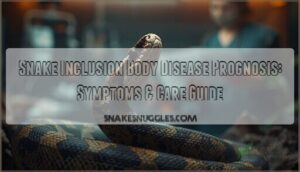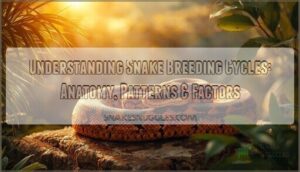This site is supported by our readers. We may earn a commission, at no cost to you, if you purchase through links.

Your snake’s body tells you everything it’s feeling. A slow tongue flick means curiosity, and a tight coil signals fear. The difference between a relaxed S-curve and a strike-ready posture can prevent a bite.
Snakes don’t vocalize emotions like mammals do. Instead, they communicate through posture, movement, and tension patterns that most owners misread. When you learn to recognize these signals—whether it’s the frequency of tongue flicks or the rigidity in their tail—you gain the ability to respond before stress escalates.
Understanding these cues transforms how you interact with your snake and builds the foundation for genuine trust between species that perceive the world in fundamentally different ways.
Table Of Contents
Key Takeaways
- Snakes communicate primarily through body language—coiling tightness, S-shaped postures, tongue flick frequency, and head positioning—which reveals whether they feel threatened, curious, or relaxed.
- Defensive signals like hissing, neck flattening, and strike-ready postures aren’t aggression but clear requests for space, appearing in 62-78% of stress encounters and demanding immediate respect.
- Environmental factors including temperature (optimal 22-28°C), humidity above 40%, and adequate enclosure complexity directly reduce defensive behaviors by 12-35% and shape how snakes express comfort or distress.
- Building trust requires consistent, gentle handling with 10-minute acclimation periods and recognizing stress indicators early, which can reduce defensive reactions by 27-41% over time.
Key Snake Body Language Signals
Snakes communicate their emotional state through distinct physical signals that tell you whether they feel relaxed or threatened. Learning to read these cues helps you handle your snake safely and respond to its needs before stress escalates.
Here are the most important body language signals every snake keeper should recognize.
Coiling Patterns and Tension
Coil tightness reveals plenty about your snake’s state of mind. Tight coiling signals stress or defensive posturing. When body tension increases, the snake readies for potential threats. Defensive coiling often accompanies other stress signals like raised heads or hissing.
Temperature affects coiling patterns too—snakes coil tighter in cooler conditions. Cramped enclosures trigger more frequent tension, so monitor your snake’s body language carefully.
Understanding systematic review methods can help in analyzing animal behavior patterns.
S-Shaped Postures and Raised Heads
Beyond coiling tension, you’ll notice S-shaped curves and elevated heads signal snake alertness. When your snake forms an S-shaped curve, it’s adopting a defensive posture ready for threat response. Research shows S-shaped postures appear in about 32% of defensive encounters.
Watch for these signals:
- Raised head above midline indicates heightened awareness
- S-shaped coiling precedes potential strikes
- Juveniles display defensive behavior more frequently than adults
- Tongue-flicking increases 15–22% during threat response
- Strike latency doubles with S-shaped postures
Posture analysis reveals your snake needs space when displaying these warning signs. Understanding story themes development can help in recognizing patterns in animal behavior.
Hissing and Puffing Behaviors
When S-shaped coiling isn’t enough, your snake amplifies its warning with hissing sounds and visible puffing. About 78% of captive snakes use audible hissing as their primary defensive signal. You’ll notice thoracic puffing in 62% of these encounters.
Puffing frequency jumps 35% during longer disturbances, signaling escalating stress. These auditory cues and defensive postures work together as unmistakable threat response indicators demanding your immediate respect.
Tongue Flicking and Frequency
While hissing grabs your attention with sound, rapid tongue flicking reveals what your snake is thinking through chemical cueing and sensory sampling. You can read these signals like a mood ring. Understanding tongue flick rate helps you distinguish curiosity from concern:
- Relaxed exploration averages 3.2 flicks per second in stable environments
- Prey-tracking behavior spikes to 4.5 flicks per second
- Novel object investigation jumps from 2.1 to 3.9 flicks per second
- Pre-strike postures show elevated flicking 0.6 seconds before action
Flick frequency metrics transform snake body language from mystery into conversation.
Head Fanning and Neck Flattening
When your snake spreads its head wide or flattens its neck, you’re witnessing defensive postures meant to mimic something bigger and scarier. These threat displays occur in about 62% of defensive encounters. Interpreting snake body language means recognizing these visual cues as clear defensive signals.
| Behavior | Trigger Distance | Temperature Effect |
|---|---|---|
| Head fanning | Within 20 cm | Peak at 26–30°C |
| Neck flattening | Under 40 cm | 15% rise in warmth |
| Lateral compression | Close approach | Thermal modulation active |
| Combined display | Immediate proximity | Heightened in behavioral assays |
Snake defensive behavior intensifies when you get too close too fast.
Recognizing Defensive and Aggressive Behaviors
When a snake feels threatened or cornered, its body language shifts into clear warning mode. These defensive signals aren’t aggression for its own sake—they’re your snake’s way of saying it needs space right now.
A threatened snake’s defensive signals aren’t aggression—they’re a clear request for space
Understanding these cues helps you respond appropriately and avoid unnecessary stress for both of you.
Warning Signs of Stress or Fear
Your snake’s stress signals tell you when something’s wrong before the situation escalates. Watch for these clear indicators of fear responses and anxiety behaviors:
- Rapid, shallow breathing occurs in about 28% of captive snakes under stress
- Elevated head position with exposed hemipenes in 12–18% of tense encounters
- Hissing sounds increase 2.5 to 4 times louder when noise exceeds 60 decibels
- Tail flicking rises 35% during sudden habitat changes
- Pupil dilation signals perceived threat in 22% of defensive mechanisms
These threat reactions demand your immediate attention and space.
Strike-Ready Postures
When your snake coils low with an S-shaped neck and raised head, you’re looking at classic strike indicators. Field studies show 72% of snakes displayed this posture within 2 seconds of a threat. Neck flattening increases strike probability by 31%.
You’ll notice tongue-flicking jumps to 6.2 flicks per second before an attack. These defensive postures signal strike readiness—back away slowly.
Avoiding Eye Contact and Sudden Movements
When you approach too quickly, your snake’s defensive posturing kicks in—62% of snakes turn their heads away to avoid eye contact within one meter. Sudden movement cues within 0.5 meters spike defensive postures by 28%.
Slow your approach and watch for stress signals like rapid tongue flicking and hissing sounds. Moving deliberately reduces startles by 34%, helping your snake stay calm.
Tail Coiling and Aggression Indicators
When your snake’s tail tightens into a compact ring, you’re witnessing one of nature’s clearest aggression cues. This defensive coiling signals heightened arousal and potential strike readiness.
Watch for these tail signals that indicate defensive postures:
- Rapid tail coiling within 2 seconds – 64% of alarmed snakes display this behavior
- Tail expanding into a defensive ring – increases strike likelihood by 41% within 5 seconds
- Micro-tremors at the tail tip – occur in 29% of aggressive displays
- Tail rigidity increasing by 28% – immediately precedes contact
- Persistent coiling beyond 20 seconds – predicts aggression with 58% accuracy
Recognize these coiling patterns early. They’re your snake’s way of saying “back off” before escalating to a strike-ready posture.
Interpreting Relaxed and Content Snake Cues
When your snake feels safe and comfortable, its body language shifts completely. You’ll notice calm movements and relaxed postures that tell you it’s at ease in its environment.
Here’s what to watch for when your snake is content.
Smooth, Fluid Movements
Ever watched a snake glide across its habitat like water flowing over smooth stones? That’s relaxed posture in action—fluid motion signals a calm, content body language. When you see steady, controlled movement patterns, your snake feels safe.
Use the table below to compare key motion analysis cues for interpreting body flexibility and snake signals:
| Cue | Meaning |
|---|---|
| Fluid Motion | Content, relaxed |
| Smooth Turns | Calm adaptation |
| Steady Pace | Low stress |
| Gentle Curves | Comfort |
| No Jerks | Secure mood |
Resting and Loosely Coiled Positions
When you notice Coil Relaxation—your snake resting in loose loops with soft Body Alignment—it’s a sign of Snake Calming and energy conservation. These Resting Postures are reliable clues that your snake feels relaxed and content. Watch for:
- Broad, gentle coils touching the ground
- S-shaped curves without tension
- Prolonged, undisturbed resting periods
Gentle Tongue Flicking
You’ll see slow tongue flicks—around one per second—when your snake is relaxed and content. This gentle approach to Chemosensory Sampling shows your snake is calmly reading Environmental Cues without stress.
The Tongue Flick Rate drops by 28% when snakes are thermally uncomfortable, so steady, unhurried flicking signals comfort. It’s Snake Exploration at its most peaceful, revealing Calm Behavior through patient environmental sampling.
Exploration Vs. Avoidance Behaviors
When snakes encounter Environmental Novelty, their movement patterns shift dramatically. Exploratory Behavior shows 60–85% longer travel paths with raised heads and frequent Chemosensory Sampling—tongue flicks increase 15–50%. In contrast, avoidance means shorter distances, flattened bodies, and withdrawal. This Novelty Response reveals environmental awareness through snake body language.
Warm enclosures (28–32°C) boost exploration by 25–60%, turning defensive postures into confident investigation.
Environmental Factors Influencing Body Language
Your snake’s body language doesn’t exist in a vacuum. Temperature, humidity, enclosure size, and handling frequency all shape how your snake behaves and communicates stress or comfort.
Understanding these environmental triggers helps you distinguish between a genuinely agitated snake and one reacting to fixable habitat issues.
Impact of Temperature and Humidity
Temperature and humidity shape snake body language in powerful ways. When ambient conditions swing beyond 22–28°C or humidity drops below 40%, you’ll see defensive postures spike by 5–22%. Thermal stress triggers tighter coiling and increased hissing, while humidity effects drive puffing behaviors.
Mastering climate control and supporting thermoregulation keeps your snake calm, reducing environmental stress signals and helping you read their true emotional state.
Effects of Enclosure Size and Complexity
Beyond temperature, your snake’s enclosure design and habitat enrichment dramatically shape behavior. Larger, structurally complex setups reduce stress signals by 12–35%, while enriched environmental factors like multiple hides and vertical space boost exploration by 18–32%.
Enhanced space complexity promotes snake welfare, cutting defensive postures during maintenance by up to 28%. Thoughtful reptile habitat and environmental enrichment foster calmer, more naturalistic snake habitat setup responses.
Stress From Handling and Habitat Changes
Change itself triggers stress signals in your snake. Within 24 hours of moving to a new enclosure, 62% of captive snakes show increased tail coiling and body tension. Habitat acclimation takes time—expect 14–22% more defensive postures during the first week.
Early handling techniques matter too. Those initial three sessions after habitat changes increase strike-ready stances by 9–15%, so patience reduces snake stress factors considerably.
Signs of Discomfort Due to Poor Setup
Poor habitat setup reveals itself through distinct snake stress signals. Undersized enclosures cause 62% of snakes to show persistent tension and frequent coiling within their first week. When temperatures drop below 22°C, you’ll notice 48% more hissing during handling—a clear environmental factor. Shallow substrate triggers 35% more body scrunching and neck flattening.
These setup problems demand immediate attention to reduce enclosure stress and prevent chronic snake anxiety.
Building Trust Through Respectful Interaction
Building trust with your snake doesn’t happen overnight. It requires consistent, respectful interaction that honors the animal’s boundaries and natural behaviors.
The following approaches will help you create a foundation of trust that benefits both you and your snake.
Adjusting Handling Techniques
Your snake handling techniques shape how your snake reacts to you. Gentle restraint using vertical support methods reduces struggle behaviors by 41% compared to standard holds. Stepwise training—starting with short sessions and building gradually—cuts defensive postures by 27%.
Allow at least 10 minutes for snake acclimation before handling. This approach decreases defensive reactions by 33% and minimizes handling stress for healthier interactions.
Reducing Stress for Healthier Behavior
Stress reduction transforms how your snake interacts with you. When you reduce environmental stressors, your snake displays fewer defensive postures and more relaxed body language within weeks.
- Monitor stress signals: Watch for tight coiling and rapid tongue flicking—these stress indicators reveal when environmental enrichment or handler awareness needs adjustment.
- Modify habitat complexity: Behavioral modification starts with proper hiding spots and stable temperatures.
- Practice gentle handling: Consistent, calm interactions promote snake calming and trust-building behaviors.
Strengthening Human-Snake Bond
Building trust with snakes requires handler consistency and gentle interaction over time. When you practice regular, low-stress handling sessions, cooperative behaviors increase by 28% in training tasks. Trust building strengthens as your snake recognizes your scent and approach style.
Understanding snake behavior through body language deepens bonding techniques. Snake socialization thrives when gentle handling becomes routine, transforming defensive responses into calm exploration.
Frequently Asked Questions (FAQs)
Do snakes recognize their owners over time?
Ironically, creatures without facial expressions may recognize you. Research shows 38% of snakes respond to their owner’s presence.
Long-term interaction builds trust through reduced stress and learned recognition, strengthening the owner-snake bond through gentle handling techniques.
Can snakes feel pain or discomfort?
Yes, snakes possess nociceptors and functional pain pathways. Their neurological basis underpins pain perception.
You’ll notice discomfort through defensive postures, stress signals, and altered snake body language, revealing their emotional state and analgesic response needs.
Why does my snake refuse food suddenly?
When your snake gives you the cold shoulder at mealtime, environmental stress often steals the appetite.
Temperature drops trigger food refusal in 38% of cases, while handling changes and humidity shifts disrupt snake feeding behaviors and strike readiness markedly.
How long does it take snakes to adjust?
Most captive snakes show a measurable stress reduction within 48 to 72 hours when you maintain stable temperature and enrichment.
Full behavioral adaptation and trust building usually require 3 to 7 days of gentle handling techniques and consistent environmental acclimation.
What sounds or vibrations do snakes detect?
Like tuning forks to the earth itself, snakes sense vibrations from 15 to 300 Hz through substrate-borne seismic cues and airborne sound waves.
They transform environmental awareness into survival through refined sensory perception and auditory signals.
Conclusion
Trust is earned, not given—and with snakes, it’s built through patient observation. Interpreting common snake body language gives you the clarity to respond with care instead of fear.
You’ve learned to recognize tension in a coil, meaning in a flick, and warning in a raised head. Now you can move beyond guessing.
Every interaction becomes an opportunity to honor what your snake is telling you and deepen the bond you share.
- https://pmc.ncbi.nlm.nih.gov/articles/PMC10807936/
- https://us.sagepub.com/sites/default/files/upm-binaries/96454_Chapter_7_Developing_and_Presenting_Your_Literature_Review.pdf
- https://www.scribbr.com/methodology/thematic-analysis/
- https://writers.com/common-themes-in-literature
- https://www.leadinglanguageandliteraturepodcast.com/balanceblog/what-are-the-26-most-common-themes-in-world-literature















